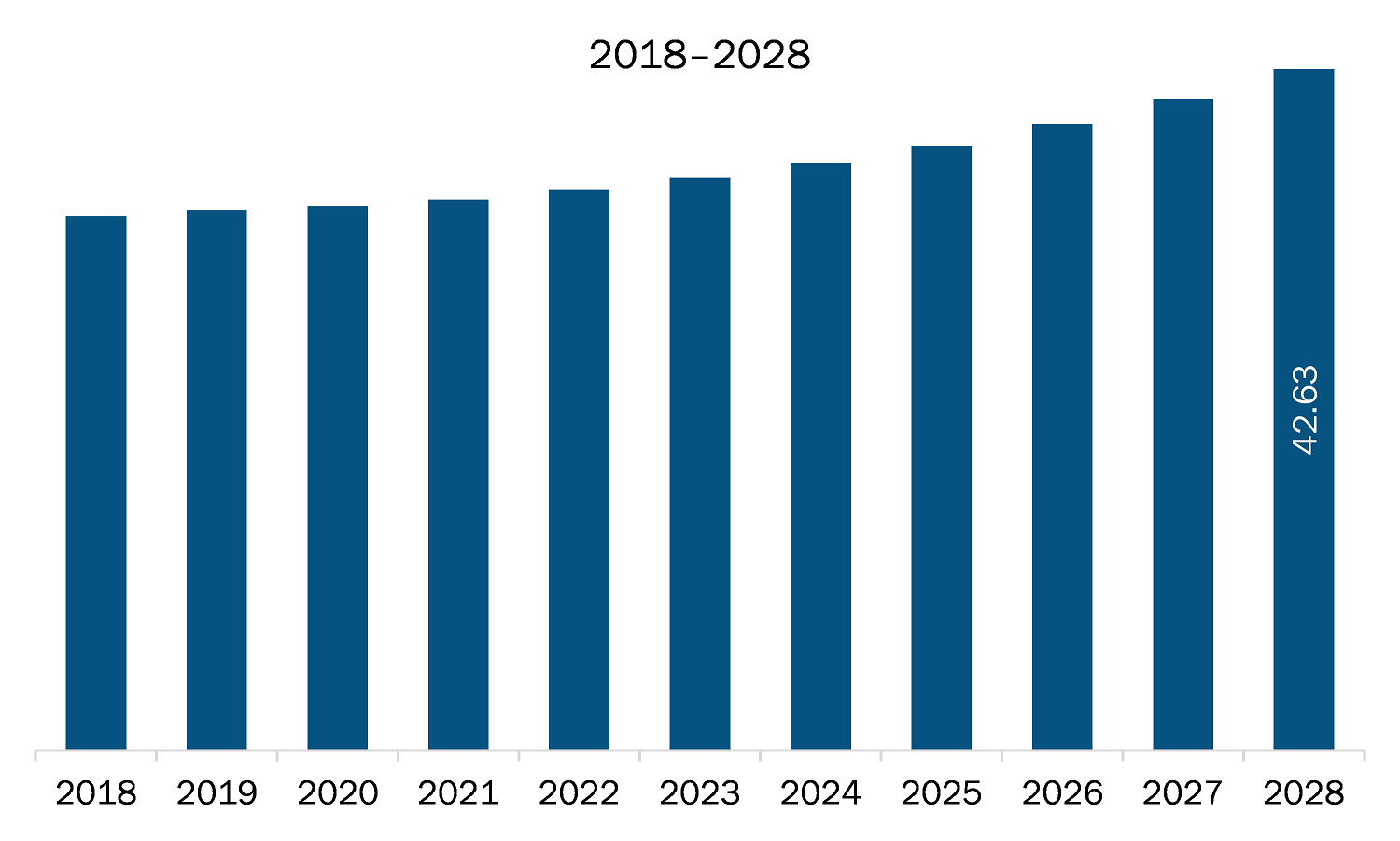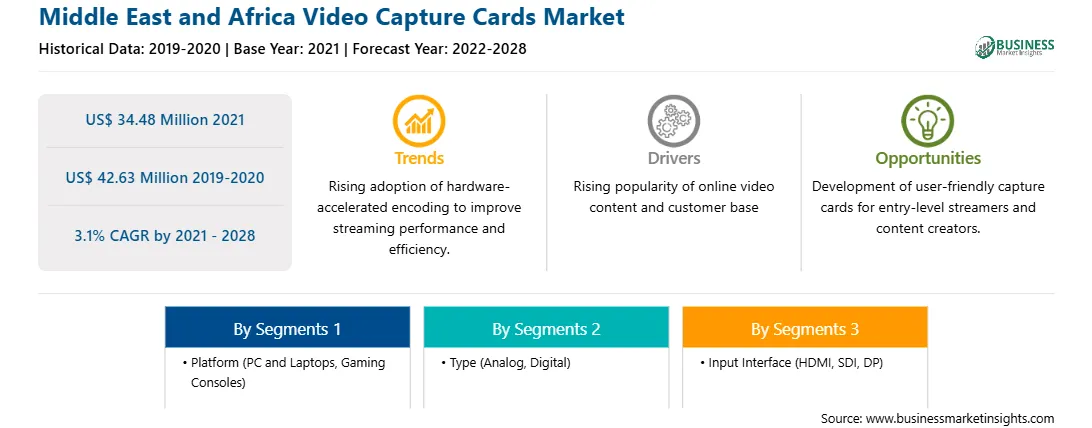The video capture cards market in the Middle East and Africa is segmented into South Africa, Saudi Arabia, the UAE, and Rest of the Middle East and Africa. The market growth in this region is attributed to the rising advancements and investments in the media and entertainment sector, which is undergoing significant digitization. The increasing consumption of digital content across different social media platforms, OTT platforms, and other streaming sites is propelling the adoption of video content, which will increase the deployment of video capture cards. With the ongoing transformation in the media and entertainment industry, the demand for various film-making solutions and services, including video capture cards, has increased in the region. As a result, many video capture card providers have expanded their presence in the region to meet the emerging demand of production companies or independent artist making films and TV shows. Also, increase in adoption of thunderbolt video interface is the major factor driving the growth of the MEA video capture cards market.
Saudi Arabia, the UAE, Egypt, Morocco, and Kuwait are the main countries facing the economic effects of COVID-19 in the Middle East and African region. It is becoming clear with the COVID-19 pandemic spreading through the above-mentioned countries that few can avoid its effects, posing major challenges for all sectors. The outbreak has led to more people staying indoors across the region, thereby, have led to the high adoption of online and video games across the region. At the peak of Covid-19 lockdowns and social distancing in the area, gaming in the Middle East more than doubled between March and April. Twitch registered a total of 65,582 streams during the time span, which enables users to broadcast their gameplay live to fans around the world. This rise in gaming across the region created high demand for video capture cards. However, owing to the temporary closure of high economic activities the region experienced a shortage of supply of video capture cards with respect to both manufacturing and supply chain. Thus, the above-mentioned factors are expected to have adverse impact on the video capture cards market owing to the outbreak of the pandemic.

Strategic insights for the Middle East and Africa Video Capture Cards provides data-driven analysis of the industry landscape, including current trends, key players, and regional nuances. These insights offer actionable recommendations, enabling readers to differentiate themselves from competitors by identifying untapped segments or developing unique value propositions. Leveraging data analytics, these insights help industry players anticipate the market shifts, whether investors, manufacturers, or other stakeholders. A future-oriented perspective is essential, helping stakeholders anticipate market shifts and position themselves for long-term success in this dynamic region. Ultimately, effective strategic insights empower readers to make informed decisions that drive profitability and achieve their business objectives within the market.

| Report Attribute | Details |
|---|---|
| Market size in 2021 | US$ 34.48 Million |
| Market Size by 2028 | US$ 42.63 Million |
| Global CAGR (2021 - 2028) | 3.1% |
| Historical Data | 2019-2020 |
| Forecast period | 2022-2028 |
| Segments Covered |
By Platform
|
| Regions and Countries Covered | Middle East and Africa
|
| Market leaders and key company profiles |
The geographic scope of the Middle East and Africa Video Capture Cards refers to the specific areas in which a business operates and competes. Understanding local distinctions, such as diverse consumer preferences (e.g., demand for specific plug types or battery backup durations), varying economic conditions, and regulatory environments, is crucial for tailoring strategies to specific markets. Businesses can expand their reach by identifying underserved areas or adapting their offerings to meet local demands. A clear market focus allows for more effective resource allocation, targeted marketing campaigns, and better positioning against local competitors, ultimately driving growth in those targeted areas.

The video capture cards market in MEA is expected to grow from US$ 34.48 million in 2021 to US$ 42.63 million by 2028; it is estimated to grow at a CAGR of 3.1% from 2021 to 2028. Video gaming is no longer exclusively enjoyed by youngsters. With the constant development of the gaming industry, people of diverse age groups are progressively inculcating gaming culture in their daily routine. Several people play video games for their leisure, while some foresee it as a lucrative career option. The percentage of internet users in MEA region is 83%. The internet gaming users among different age group such as 23–26 (Millennial), 37–55 (Gen X), and 16–22 (Gen Z) is estimated to be around 48%, 25%, and 23% respectively. Additionally, the adoption of gaming consoles such as Microsoft’s Xbox Series X, Sony’s PlayStation 5, and Nintendo Switch is growing swiftly, which illustrates the surging interest of gamers toward adoption of advanced consoles. Further, increasing adoption of gaming consoles is driving the sales of video capture cards. Also, the console owners are looking forward to improvising next-generation consoles to enhance gaming experience. In the last few years, the professional gamers have undergone strict training in state-of-the-art facilities, using gaming analytics, with an aim to enhance their performance. The above-mentioned facts associated to demographics, adoption of sales, and professionalization of gaming are highlighting the importance of gaming trend, which, in turn is driving the growth of the video capture cards market.
The market for MEA video capture cards market is segmented into platform, type, input interface, and country. Based on platform, the market is segmented into gaming consoles, PC and laptops, and others. The gaming consoles segment dominated the market in 2020 and others segment is expected to be the fastest growing during the forecast period. Based on type, the market is segmented into digital and analog. The digital segment dominated the market in 2020 and is expected to be the fastest growing during the forecast period. Based on input interphase, the market is segmented into HDMI, DP, SDI, and others. The HDMI segment dominated the market in 2020 and others segment is expected to be the fastest growing during the forecast period.
A few major primary and secondary sources referred to for preparing this report on the video capture cards market in MEA are company websites, annual reports, financial reports, national government documents, and statistical database, among others. Major companies listed in the report are ADLINK Technology Inc.; Advantech Co. Ltd.; AverMedia Technologies, Inc.; Datapath Limited; EURESYS S.A.; and Matrox; among others.
The Middle East and Africa Video Capture Cards Market is valued at US$ 34.48 Million in 2021, it is projected to reach US$ 42.63 Million by 2028.
As per our report Middle East and Africa Video Capture Cards Market, the market size is valued at US$ 34.48 Million in 2021, projecting it to reach US$ 42.63 Million by 2028. This translates to a CAGR of approximately 3.1% during the forecast period.
The Middle East and Africa Video Capture Cards Market report typically cover these key segments-
The historic period, base year, and forecast period can vary slightly depending on the specific market research report. However, for the Middle East and Africa Video Capture Cards Market report:
The Middle East and Africa Video Capture Cards Market is populated by several key players, each contributing to its growth and innovation. Some of the major players include:
The Middle East and Africa Video Capture Cards Market report is valuable for diverse stakeholders, including:
Essentially, anyone involved in or considering involvement in the Middle East and Africa Video Capture Cards Market value chain can benefit from the information contained in a comprehensive market report.